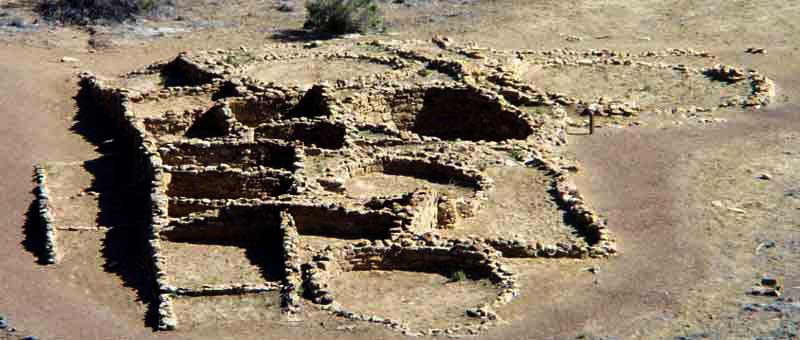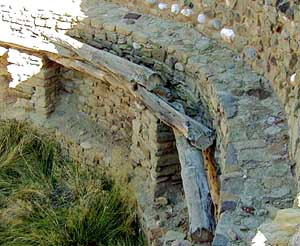Small Houses
Before we go on something more needs to be said about great houses and great kivas, to emphasize their difference from small houses (unit pueblos) and ordinary round rooms (kivas), such as those that may be viewed on the path leading to Casa Rinconada. It's so obvious that it needs to be pointed out (yes, I meant to say that) that buildings such as Pueblo Bonito and Chetro Ketl took a lot of work to build (Leckson 1986; Metcalf 2003). Unlike the mystery that for many years surrounded the construction of the pyramids in Egypt, the "how" of Chaco construction is straightforward: hard work, pure and simple. The first-time tourist who strolls through Pueblo Bonito with a Park Service summer intern guide (that was me) sees the different masonry styles, the corner and T-shaped doors, the multitude of round rooms, and 4-story standing walls—but the magnitude of the effort required to make these things doesn't sink in until later when thinking back on the experience.
Small houses, on the other hand, while not exactly slapped together, were built and rebuilt as they were needed, unlike the carefully planned great houses. Small houses were residences while great houses were public buildings in which some people lived.
Archaeologists of the early twentieth century thought these small houses preceded the great houses, that there was a developmental progression from small houses to great houses. But after tree-ring dating (dendochronolgy) became available in the 1920s and was applied to timbers in houses great and small, it was shown that the different styles coexisted.
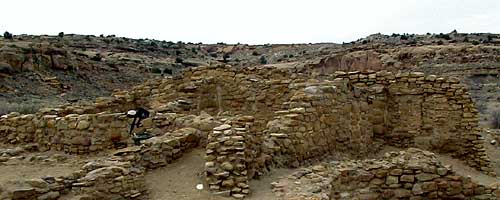 |
Chaco Canyon contains scores of these small 1-story houses. Most of them are on the south side of Chaco Wash opposite the great houses that nestle under the cliff to the north. A natural assumption is that the inhabitants of the small houses were working class people who carried the burden of constructing the great houses. It's possible that that was, indeed, the case, even though, as some archeologists believe, they were of an entirely different cultural origin and were simply farmers. On the other hand, no one has found any work gang notes such those found in Khufu's Great Pyramid, so the jury is still out.
|
In Report #3 I pointed out that Casa Rinconada, an "isolated" great kiva, was not located within or near a great house. Instead, it was situated to serve the inhabitants of a large number of nearby small houses. Does that mean that Chacoan villages had no need for kivas of their own? By no means! They had many, many of them, as well they should since, as we saw in Report #2, what are called kivas are the pit house centers of unit dwellings. This one appears to be extremely deep because it really is three round rooms built one on top of the other. Incidentally, the large block that looks as if it doesn't belong in a kiva…doesn't; it was put there by the Park Service to stabilize the curved wall.
|
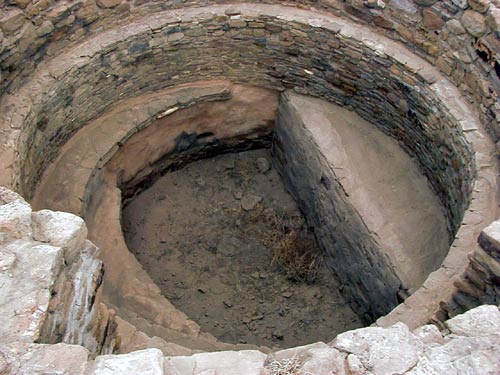 |
Part of the debris removed during excavation is the remains, if any, of the roof. Much can be learned from it, including what caused the roof to fall. A bed of ashes, for instance, is a dead giveaway. Excavation of many regular "kivas" has revealed that the roof usually was built up by placing logs from one internal support along the perimeter wall to another, as in the photo above (left) from Aztec Ruins. The logs were then put one on another until they formed a dome over the interior. A square opening was left in the center of the dome, which both allowed smoke to escape and permitted the introduction of a ladder for people to enter. The space between the top of the corbeled logs and the surface was then filled with rock and dirt, making the roof (from the exterior) flat. The resulting effect would have been similar to that of this reconstructed "kiva" at Spruce Tree House in Mesa Verde National Park.
Click here for an image of a cribbed roof from the interior of a reconstruction at Edge of the Cedars State Park, Blanding, UT. |
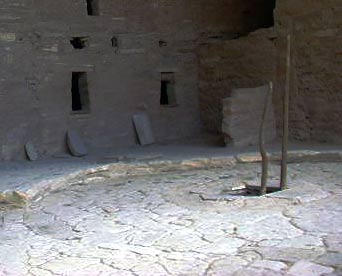 |
|
